Although Washington, District of Columbia is more famous for being the seat of the federal government, the area also boasts several thousand plant and animal species. However, we’re only concerned about the snakes in this article.
Of the 13 snakes that can live near Washington, D.C., we were able to confirm sightings of 11. Regardless, we included all 13 because we love snakes!

Eastern Garter Snake (Thamnophis sirtalis)
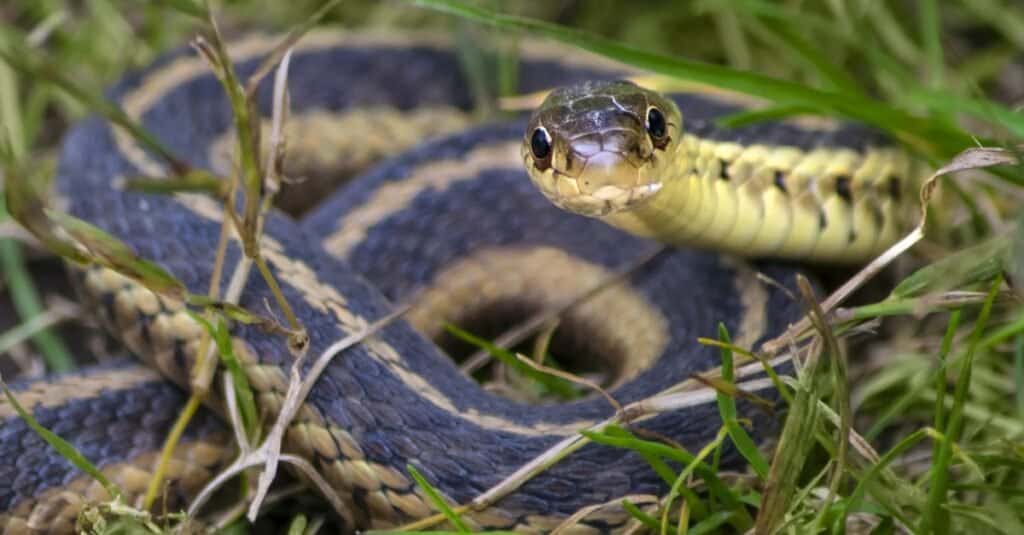
Common eastern Garter snake, coiled in the grass. Garter snakes don’t have fangs and aren’t venomous. However, they do have a few rows of small teeth and can bite.
©K Quinn Ferris/Shutterstock.com
Eastern garter snakes are common across North America. They are harmless colubrid snakes that grow to about 53 inches and 5.3 ounces.
Easily identified, eastern garter snakes have a dorsal stripe in a contrasting color that can range from pale yellow to orange. Some individuals also have a stripe on each side of their body, but sometimes it merges with the base color.
Although these snakes are harmless to people, they have venomous saliva. It’s prey-specific and only affects their favorite foods—amphibians. Garter snakes are one of the most common snakes in Washington, D.C.
Eastern Ratsnake (Pantherophis alleghaniensis)
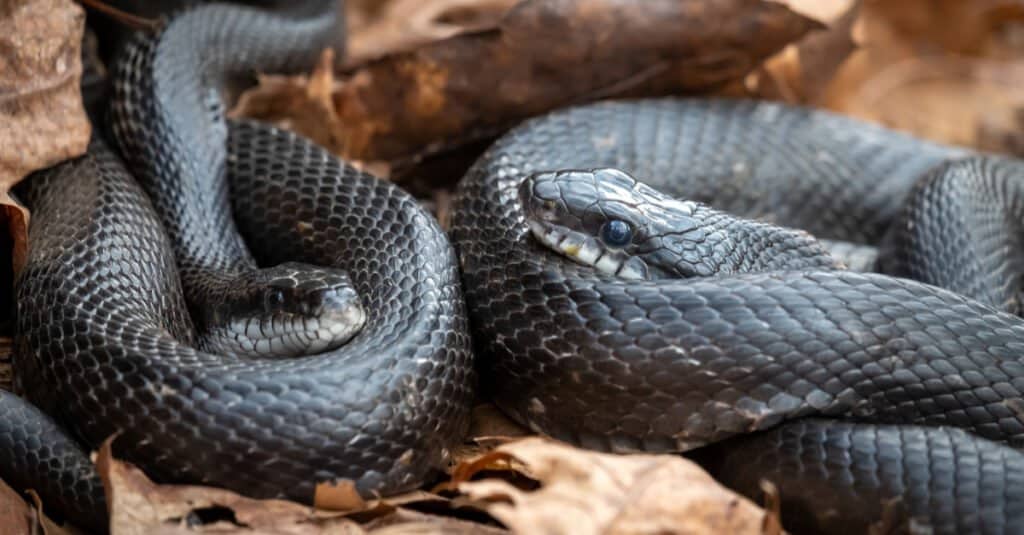
A pair of Eastern Ratsnakes (
Pantherophis alleghaniensis) snuggle during the spring season.
©samray/Shutterstock.com
Eastern ratsnakes are common along the eastern seaboard of the U.S., east of the Appalachian Mountains. Adults are relatively large and can measure over six feet long.
Juveniles have darker blotches over a gray or brown base color which darkens to shiny black as they mature. Adults and juveniles have black and white checked patterns on their bellies; the throat and chin of adults is a creamy white.
Although they’re often confused for the next snake, northern black racers, eastern ratsnakes have smaller eyes in proportion to their heads, and their heads are somewhat distinct from their necks. Ratsnakes also have slightly keeled scales in comparison to the racers’ smooth glossy scales.
This species (like all other ratsnakes) is an excellent climber. Ratsnakes startle people by being in odd places—climbing a vertical wall via the grout lines is common. They are equally comfortable slithering through the trees as they are in the garage rafters.
Northern Black Racers (Coluber constrictor)

Black racer snake crawling through Saint Augustine grass in Florida.
©iStock.com/sdbower
Northern black racers are found across much of North America. These nonvenomous colubrids are long and slender, usually measuring between 35 and 75 inches in length.
Racers have startled many people by cruising around with their heads raised above the brush. Periscoping behavior is common among racers, as diurnal predators, they have large eyes and good eyesight that they use to locate prey.
This species is often confused for eastern ratsnakes because they both become black, or mostly black, as adults. However, Northern black racers are easy to distinguish, because they have larger eyes set into smaller heads and smooth glossy scales.
Because they’re shy snakes, you’re most likely to see a North American Racer’s tail as it makes a hasty retreat.
Common or Banded Watersnake (Nerodia sipedon)
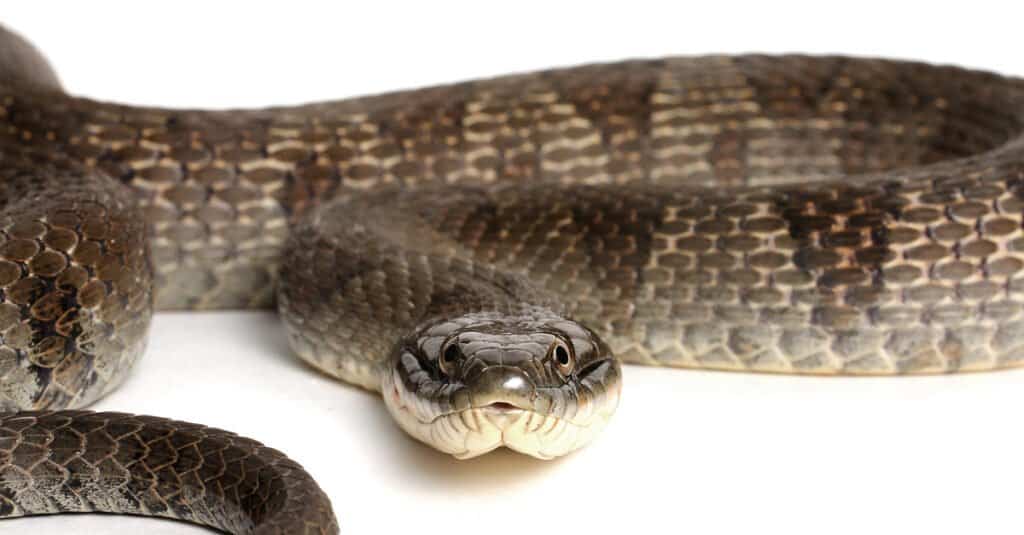
©Michiel de Wit/Shutterstock.com
Appropriately named, the common water snake is common in the eastern half of the United States. It’s one of the most common snakes sighted in Washington, D.C. It’s not huge, but can reach about four feet long.
Watersnakes have keeled scales, thick bodies, and triangular heads—and they’re nonvenomous. Yes, all those things you were told about how head shape can tell you whether it’s venomous aren’t always accurate.
Here’s the truth: most snakes can spread their heads out to make it look larger. It’s a defensive display. Snakes have extra joints in their heads that make it possible to swallow large prey, so it’s more flexible. Your best bet is learning to identify the snakes in your area.
Common watersnakes have a lighter base color that ranges from tan to olive with darker crossbands. As they mature, they become almost solid-colored, but you can still see some of the patterns. This species has round pupils and their head is often darker-colored than their chin, giving it a two-toned appearance.
Although these snakes aren’t venomous, they have razor-sharp teeth! They eat fish and amphibians and catch their prey right out of the water, making those teeth necessary. Common watersnakes defend themselves violently, biting repeatedly. You will not walk away unscathed after trying to catch one.
Dekay’s Brownsnake (Storeria dekayi)
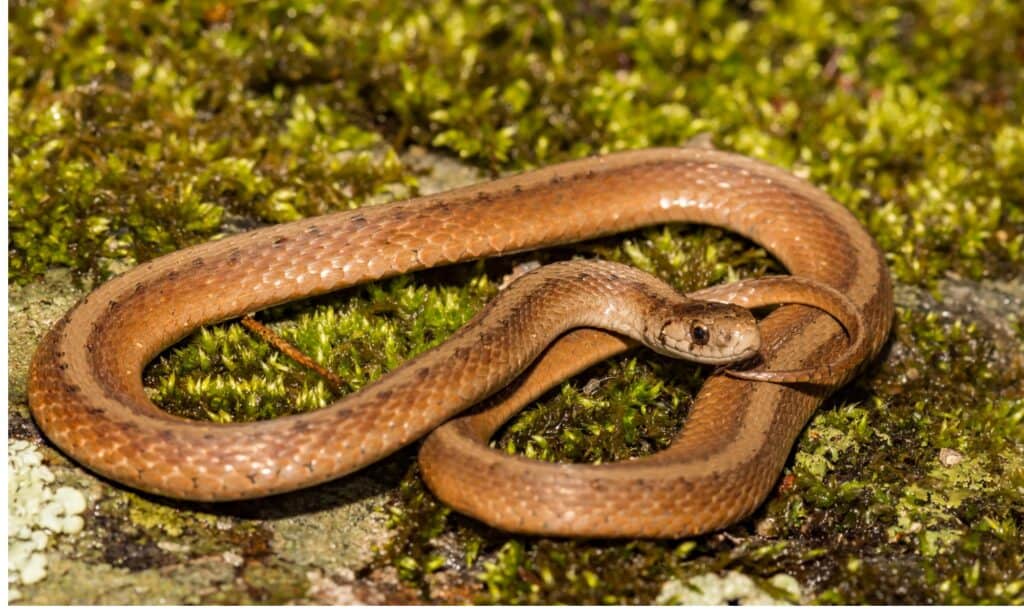
Northern brown snakes are the type species for Storeria dekayi
©iStock.com/JasonOndreicka
Another harmless snake, Dekay’s brownsnake is common across the eastern half of the U.S. Where the common watersnake is chunky and ready to bite, Dekay’s brownsnake is small and will probably never bite. Even if it did, it’s so small it couldn’t hurt you.
Adult Dekay’s brownsnakes measure less than 12 inches long. They’re often confused with garter snakes because they also have a dorsal stripe. However, these snakes probably won’t musk you and typically aren’t found in water. This species prefers staying under rocks, mulch, and leaf litter where their prey resides. Dekay’s brownsnakes eat slugs, worms, snails, and other soft-bodied insects.
Their base color is medium brown to gray and it’s overlaid with a darker spotted pattern on either side of the dorsal stripe.
Northern Ring-Necked Snake (Diadophis punctatus edwardsii)

Northern ring-necked snake (
Diadophis punctatus edwardsii) being examined.
©CampSmoke/Shutterstock.com
Common around Washington, D.C., northern ring-necked snakes inhabit the eastern two-thirds of North America. These colubrids usually grow to about 10- 15 inches long. Their color varies and can be smoky black, bluish-gray, brown, or olive.
Ringneck snakes are easily identified by the contrasting neckband which usually matches the belly color of yellow, yellowish-orange, or red. They have very mild venom and enlarged rear teeth (not fangs) that puncture their prey to allow it to drip into the victim—much like a garter snake!
These snakes hide in mulch and under rocks, where they eat snails, slugs, worms, and other small arthropods.
Eastern Worm Snake (Carphophis amoenus)
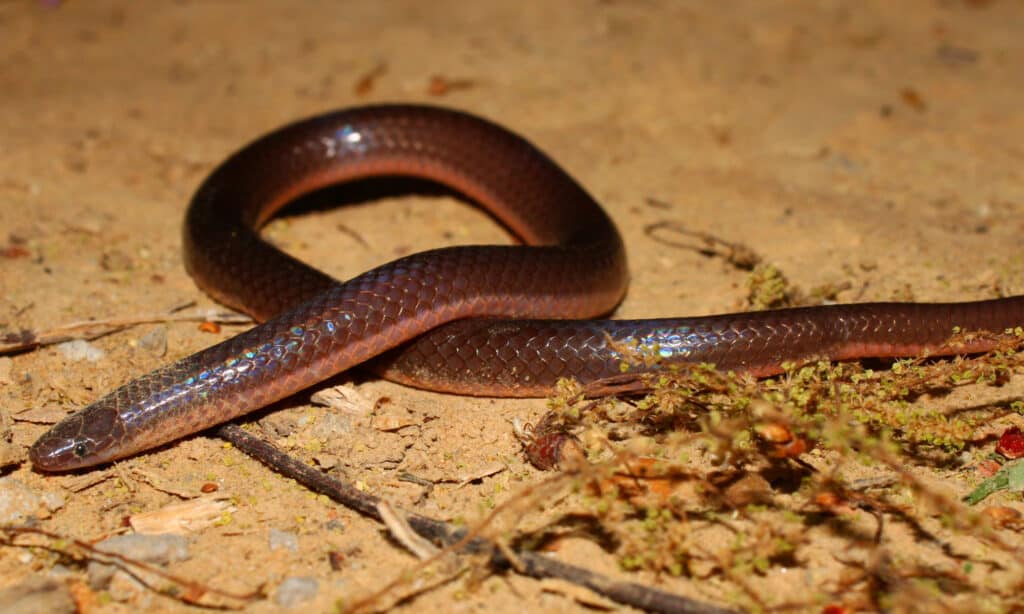
©Jason Patrick Ross/Shutterstock.com
Is it a worm, or a snake? In this case, definitely a snake. Yet, it’s not a snake that should worry you. It’s nonvenomous and tiny. In fact, the largest worm snake ever found was a whopping 13 inches long.
This species is usually a reddish brown that’s darker on the back than the belly. Worm snakes are nocturnal predators that prefer to live on the outskirts of town, whether “town” is your yard, or the edges of a forest clearing. The best time to find it is after a heavy rain, because, like the earthworms it eats, the worm snake must also come up for air.
Unlike other snakes, whose scales help protect them from dehydration, the eastern worm snake’s skin and scales evaporate water quickly. So, its habitat needs to have enough humidity to offset the fluid loss.
The eastern worm snake only lives in the eastern U.S., and is common in pockets in Washington, D.C.
Eastern Copperhead (Agkistrodon contortrix)

Trans-Pecos Copperhead,
Agkistrodon laticinctus pictigaster, lying on gravel.
©Jeff W. Jarrett/Shutterstock.com
The only venomous snake usually found in Washington, D.C., copperheads have a typical chunky pit viper body and large head. However, they’re not as dangerously venomous as other pit vipers.
Copperheads are smallish, and only measure two to three feet long as adults. One of their favorite snakes are the cicadas in the summer and they will climb trees to get to the insects! They also eat small rodents and lizards, but unlike other pit vipers, have no problem living near people.
This species gets its common name from the copper to bronze-colored head. Its eyes often match the head color and it has vertical pupils. As pitvipers, they have large venom glands behind their eyes that connect to the also frightening fangs that fold into the roof of their mouth when not needed.
Copperheads have a pinkish-to-gray base color with hourglass-shaped crossbands. However, if you see the crossbands from the side, they look like chocolate kisses—but don’t boop this snoot!
The copperhead isn’t very common here. However, of the possible venomous snakes, it’s the most likely to be spotted in Washington, D.C.
Queensnake (Regina septemvittata)

The queen snake is a non-aggressive, non-venomous snake found in North America
©Jason Patrick Ross/Shutterstock.com
Another nonvenomous, water-loving snake, queensnakes tend to stay in or near water sources. Their diet consists almost entirely of eating recently molted crayfish—over 90%! They choose the newly molted crayfish because they’re defenseless and can’t injure the snake.
These snakes resemble garter snakes in their body and head shape, so they’re often confused with garters. Unlike garter snakes, queensnakes are solid-colored and lack the dorsal stripe. Instead, they have stripes on their belly.
Queensnakes are small, slender, and rarely grow longer than 24 inches. They’re more rare, but mostly because they’re shy and have very specific dietary needs.
Rough Green Snake (Opheodrys aestivus)

Rough green snakes have lightly keeled scales and a bright green color.
©iStock.com/Shoemcfly
Sometimes called a grass snake, the rough green snake has a bright green back with a yellowish belly. It’s a nonvenomous colubrid that can get pretty long at about 45 inches. However long it grows, the rough green snake is very slender with keeled scales and large eyes.
Rough green snakes eat frogs, arthropods, snails, and other insects. They don’t constrict their prey and just swallow it alive. This species is common throughout the southeastern United States, but not as common in and around Washington, D.C.
Eastern Kingsnake (Lampropeltis getula)
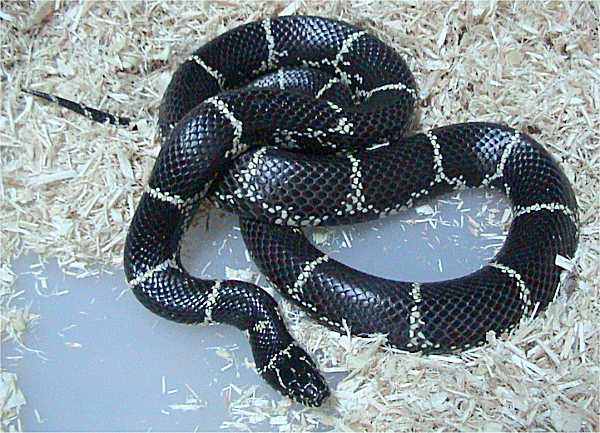
Kingsnakes have developed a hunting strategy that prevents getting bitten, where they clamp down on the other snakes’ jaws.
©en:User:Dawson, CC BY-SA 2.5 – License
Another nonvenomous colubrid, the eastern kingsnake is a favorite among herpetoculturists. There are several subspecies, all with differences in patterns, and even within the subspecies, they can vary widely. Eastern kingsnakes are mostly black with yellow or white crossbands.
Their heads flow smoothly right into their bodies, with almost no distinction in the neck. Kingsnakes eat other snakes, including venomous copperheads, rattlesnakes, and coral snakes. They’re also not picky about which snake species they eat. Kingsnakes have developed a hunting strategy that prevents getting bitten, where they clamp down on the other snakes’ jaws. However, even if they do get bitten, they’re resistant to the venom!
No matter how much snakes frighten you, you’ve got to love a snake that takes care of the really dangerous species! Eastern kingsnakes aren’t as common in the D.C. area but are common across most of the eastern United States.
Timber Rattlesnake (Crotalus horridus) — Probably Exirpated
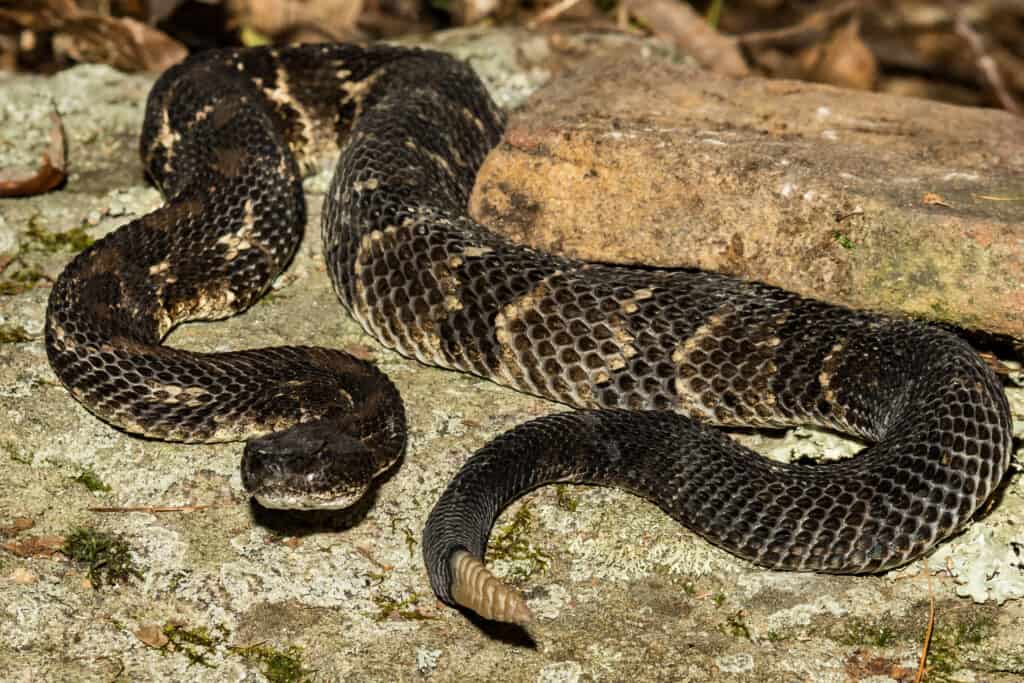
Black phase Timber Rattlesnakes have dark speckles all over their bodies that make them look much darker.
©iStock.com/JasonOndreicka
This species hasn’t been seen in D.C. for many years and it’s believed to be extirpated. However, there are sporadic claims of sightings, so we’re including them.
Timber rattlesnakes are large pit vipers that can inject enough venom to kill a person. Fortunately, they aren’t in a hurry to bite and try very hard to be left unseen.
These snakes have a gray base color with darker V or M-shaped crossbands. The further north, the darker the base color and some are almost black. However, the rattle is unmistakable! Even if you aren’t certain which rattlesnake you see, you’ll know it’s a rattlesnake.
As ambush predators, timber rattlesnakes are fairly sedentary. So, when someone’s bitten its because they’ve either harassed or stepped on it.
Corn Snake (Pantherophis guttatus)

A beautiful corn snake in the garden. The name corn snake may have originated from the markings on this snake’s belly, which resemble maize, or Indian corn.
©Enrique Ramos/Shutterstock.com
You’re not likely to see a corn snake in Washington, D.C., because the nation’s capitol sits at the far northern edge of its range. However, if there’s even a small chance, these adventurous snakes will take it.
Corn snakes are so named because they hang around grain stores waiting for rodents. Or because their belly pattern resembles Indian corn. Or, actually, no one really knows but everyone has an idea.
Technically, corn snakes are a type of rat snake and have the same type of pattern on their backs. The difference is that corn snakes are bright orange and red to brownish red. Growing to about six feet, they’re long and slender, but very muscular.
Summary of 13 Snakes Near the Washington DC Region
| Number | Snake |
|---|---|
| 1 | Eastern Garter Snake |
| 2 | Eastern Ratsnake |
| 3 | Northern Black Racers |
| 4 | Common or Banded Watersnake |
| 5 | Dekay’s Brownsnake |
| 6 | Northern Ring-Necked Snake |
| 7 | Eastern Worm Snake |
| 8 | Eastern Copperhead |
| 9 | Queen Snake |
| 10 | Rough Green Snake |
| 11 | Eastern Kingsnake |
| 12 | Timber Rattlesnake |
| 13 | Corn Snake |
The photo featured at the top of this post is © Matthew L Niemiller/Shutterstock.com
Discover the "Monster" Snake 5X Bigger than an Anaconda
Every day A-Z Animals sends out some of the most incredible facts in the world from our free newsletter. Want to discover the 10 most beautiful snakes in the world, a "snake island" where you're never more than 3 feet from danger, or a "monster" snake 5X larger than an anaconda? Then sign up right now and you'll start receiving our daily newsletter absolutely free.
Thank you for reading! Have some feedback for us? Contact the AZ Animals editorial team.






